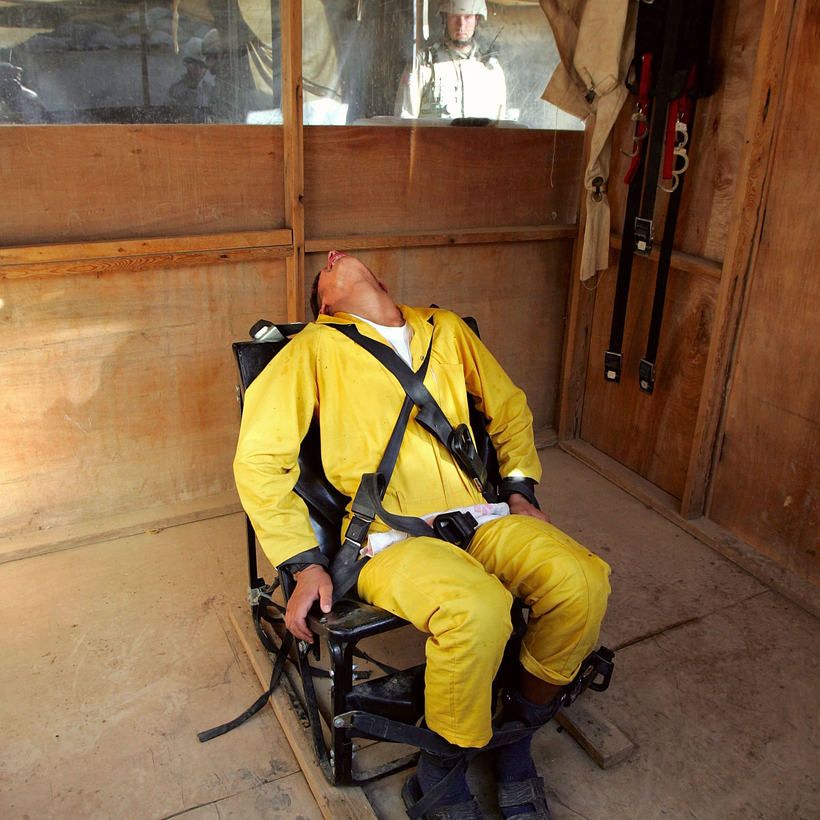In 2014, I came across an old Vanity Fair article called “Rorschach and Awe,” by Katherine Eban. It told the story of two psychologists who, as private contractors, designed and implemented the C.I.A. interrogation program that operated in the wake of 9/11 and on behalf of our country. The article suggested that two men in particular—Dr. James Mitchell and Dr. Bruce Jessen—had somehow come up with a “special sauce” that they claimed would allow them to extract information from captured terrorists, particularly al-Qaeda prisoners, who had somehow been trained to withstand all other forms of interrogation. According to the contractors, the recipe for the special sauce simply required “reverse engineer[ing]” training techniques used to prepare U.S. Special Forces for what might befall them should they find themselves in the hands of the vilest regimes on the face of the earth.
The notion that this could actually work begins by torturing logic and science before moving on to cause the most unrecognizable contortions of the law—but, hey, it was the aftermath of a massive intelligence failure and C.I.A. seemed to stand for “Confused, Ineffective, and Angry.” The techniques the agency was able to persuade the Office of Legal Counsel to approve included such innovations in intel collection as “the insult slap,” “walling,” and a medieval device called “the waterboard”—as well as nine other measures that most people with a command of the English language and a shred of empathy would just call torture.

The Nazis had a program that involved many of these vicious techniques. Their methods were called Verschärfte Vernehmung. The English translation is “enhanced interrogation.” The C.I.A. decided to call their program by essentially the same name: “enhanced interrogation techniques.” Not calling it torture makes a fair amount of sense; after all, torture is against U.S. law. And the Justice Department has no shortage of lawyers who might point that out. However, when coming up with a euphemism for torture, one might have wanted to look elsewhere than Nazi Germany for suggestions. For instance, if the C.I.A. were going to launch a cruise ship, I would dissuade them from calling the vessel the Titanic. During the Vietnam War, they at least called them “KUBARK.” KUBARK was the C.I.A.’s code name for itself—and the manual features such pro tips for interrogators as “the electrical current [of the site] should be known in advance, so that transformers and other modifying devices might be on hand if needed.”
The Nazis had a program that involved many of these vicious techniques during World War II.
I would be remiss here if I did not point out that the most successful Nazi interrogator, Hanns Scharff, once said: “Should you ever come into the position where you would interview a P.O.W. yourself, you should do it in a calm and friendly way. Not to bully, threaten or shout.” He did not mention “mock burials” or the “use of diapers”—which Mitchell and Jessen included in their PowerPoint to the C.I.A. as part of their sales pitch (“Contractors Inherit America”). Scharff worked on more than 500 battle-hardened U.S. and Allied pilots; his methods—using tea, coffee, cigarettes, and pleasant conversation—were effective in gaining intel from, according to Scharff, all but 20 of them. So impressed were the United States military with his success that they invited Scharff after the war to lecture at the Pentagon on how to get people to give up what they have been trained not to—what is known quite simply as “rapport building.”
The C.I.A. (“Can’t Interrogate Anyone”) seem to have missed out on this information somehow—no doubt because it has been cleverly hidden in a device called a “book” about Scharff, titled The Interrogator: The Story of Hanns Joachim Scharff, Master Interrogator of the Luftwaffe, which one can order from Amazon.

Eban’s article in Vanity Fair went on to outline a theory held by several psychologists at the time: that the American Psychological Association (A.P.A.) had agreed to allow its membership to participate in military interrogations on the condition that the government might allow psychologists—who, unlike psychiatrists, are not doctors—to prescribe medication to their patients, dramatically increasing their billings. In other words: If you allow us to demonstrate how unethical we are by torturing prisoners on your behalf, then would you give us the opportunity to make more money by offering drugs to our patients?
This struck me as a movie.
I must admit here that I was raised by two members of the A.P.A.—my mother and father. They banned the sitcom Hogan’s Heroes from our living-room TV, saying there was nothing funny about Nazis. My mother even forbade us from having a German shepherd as a pet—hoping instead that the entire breed might be brought before some sort of canine Nuremberg tribunal. (We had an Old English sheepdog instead—a breed on the right side of the Marshall Plan, as far as my mom was concerned.) Based on my upbringing, I sensed that psychology could be weaponized to achieve anxiety in teenagers, but my parents never employed any sort of enhanced parenting techniques.
This movie, I decided while walking my German shepherd, needed to be a dark comedy. Something like 1964’s Dr. Strangelove.
However, it was around this time that the U.S. Senate released its comprehensive study of the C.I.A.’s Detention and Interrogation Program, authored by lead investigator Daniel J. Jones. The classified version of the Intelligence Committee’s report is approximately 6,700 pages long and features 38,000 footnotes. Its conclusions mirror what Scharff—and F.B.I. interrogators like Ali Soufan, who used rapport building to learn the identity of the 9/11 planner—knew all along. Not only is torture a crime against humanity; it is also wildly ineffective and pollutes the intel stream with false confessions. The totalitarian regimes that practice it do so specifically to obtain false confessions to create propaganda, not to gain actionable intel that “saved” lives, as the C.I.A.’s Web site claims.
C.I.A. seemed to stand for “Confused, Ineffective, and Angry.”
The 524-page version of this study, which Jones and his team released in 2014, is also available on Amazon—albeit fairly redacted. And it was this document that became the basis for the movie The Report. In the publicly released executive summary, we learn that at least 119 detainees went through the C.I.A.’s detention-and-interrogation program. The C.I.A. itself has admitted that a quarter of those detained were guilty of nothing more than being Arab men in the wrong place at the wrong moment in history. The program did not lead us to bin Laden, as the C.I.A. claimed. It did not thwart any attacks. Mitchell and Jessen did not obtain any unique intelligence via their special sauce; they obtained zero. But the program did succeed in destroying our standing in the world as a country governed by the rule of law—although Native Americans, African people who were brought here as slaves, those seeking asylum, and a host of others had already reached the same conclusion about the U.S.’s uneven governance.
Like I said, a very dark comedy.
But the problem was the redactions. They really get in the way of storytelling.
Swigert: When is the next ███████?
Detainee: Ouch. Please stop ████ to me.
Dunbar: Tell us or we are going to ███ your ██████ We know █████████ you with ██████████.
Dunbar proceeds to █████████ the ██████████ out of █████ █████████.
The jokes were hard to find behind the black bars and even harder to see among the text that remains. For instance: “Majid Khan was then subjected to involuntary rectal feeding and rectal hydration, which included two bottles of Ensure. Later that same day, Majid Khan’s ‘lunch tray,’ consisting of hummus, pasta with sauce, nuts, and raisins, was ‘pureed’ and rectally infused. Additional sessions of rectal feeding and hydration followed.”
So, I started over.
The program did not lead us to bin Laden, as the C.I.A. claimed. It did not thwart any attacks.
The Report is the story of Jones’s Kafka-esque ordeal toiling away in a secret C.I.A. off-site basement, with a small staff assigned to tell the story of the program that Mitchell and Jessen executed on behalf of our country and for which they were ultimately paid around $80 million in taxpayer money—enough to acquire almost three million copies of Scharff’s biography. Jones’s reward for sorting through 6.3 million C.I.A. documents, emails, cables, and memos for more than half a decade was a criminal referral filed against him by the C.I.A. for hacking into the agency’s computer base. Jones’s computer skills stop at Microsoft Word, and the notion that he broke anything other than the record for the largest and most detailed investigation ever completed by the Senate is absurd. He was simply doing his job as a Senate staffer in the employ of a committee that exists in part to provide oversight to the C.I.A. But the C.I.A. decided that the right thing to do to someone pursuing the truth was to fabricate claims against him in the hopes of sending him to jail. The D.O.J. eventually dismissed the case against Jones. But a separate investigation into the C.I.A. itself concluded that the agency had broken into the computers of the U.S. Senate—a violation of the separation of powers as outlined in the Constitution, a document which the C.I.A. can also get from Amazon for future reference.

Although both the U.S. military and the F.B.I. have entire departments filled with experienced interrogators who have spent their careers obtaining intelligence and solving crimes, the C.I.A. inexplicably hired two contractors with absolutely no experience in real-world interrogations. Then they went after an American citizen who was employed to tell the truth about a program they continue to misrepresent to this very day. If only they had hired a different psychologist, Dr. James Gilligan, who said, “All violence is an attempt to replace shame with self-esteem.”
And nobody has been held accountable. Somehow the same U.S. Senate that voted to release this study also voted to make Gina Haspel the director of the C.I.A.—even though she has been identified as one of the officers who wrote orders for the destruction of tapes of torture. Senator John McCain remarked on the day the “torture report” was released that instead of considering what this program says about our enemies, we might want to reflect on what it says about us. And that is what I endeavored to do with the help of Adam Driver, Annette Bening, and Jon Hamm—in theaters this weekend and then, yes, available on Amazon.
Scott Z. Burns is a screenwriter, producer, and director


